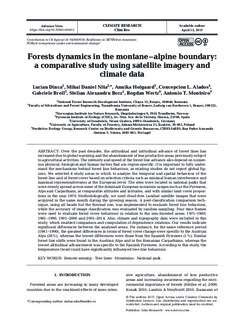Forests dynamics in the montane–alpine boundary: a comparative study using satellite imagery and climate data
Dinca, Lucian; Nita, Mihai Daniel; Hofgaard, Annika; Alados, Concepcion L.; Broll, Gabriele; Borz, Stelian Alexandru; Wertz, Bogdan; Monteiro, Antonio T.
Journal article, Peer reviewed

Åpne
Permanent lenke
http://hdl.handle.net/11250/2443740Utgivelsesdato
2017Metadata
Vis full innførselSamlinger
- Publikasjoner fra CRIStin - NINA [2397]
- Scientific publications [1423]
Originalversjon
10.3354/cr01452Sammendrag
Over the past decades, the altitudinal and latitudinal advance of forest lines has increased due to global warming and the abandonment of less productive areas previously subject to agricultural activities. The intensity and speed of the forest line advance also depend on numerous physical, biological and human factors that are region-specific. It is important to fully understand the mechanisms behind forest line behaviour, as existing studies do not report global figures. We selected 4 study areas in which to analyse the temporal and spatial behaviour of the forest line and of forest cover based on selection criteria such as minimal human interference and maximal representativeness at the European level. The sites were located in national parks that were evenly spread across some of the dominant European mountain ranges such as the Pyrenees, Alps and Carpathians, at comparable altitudes and latitudes, and with similar land cover proportions in the year 1970. Methodologically, we used cloud-free Landsat satellite images that were acquired in the same month during the growing season. A post-classification comparison technique, using all bands but the thermal one, was implemented to evaluate forest line behaviour, while the accuracy of image classification was evaluated by random sampling. Four time frames were used to evaluate forest cover behaviour in relation to the non-forested areas: 1971−1980, 1981−1990, 1991−2000 and 2001−2014. Also, climate and topography data were included in this study, which enabled comparison and computation of dependence relations. Our results indicate significant differences between the analysed areas. For instance, for the same reference period (1981−1990), the greatest differences in terms of forest cover change were specific to the Austrian Alps (28%), whereas the lowest differences were those from the Spanish Pyrenees (1%). Similar forest line shifts were found in the Austrian Alps and in the Romanian Carpathians, whereas the lowest altitudinal advancement was specific to the Spanish Pyrenees. According to this study, the temperature trend could have significantly influenced tree line behaviour. Remote sensing · Tree lines · Mountains · National park
